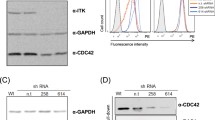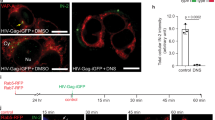Abstract
In addition to its positive signaling function in the antigen presentation process, CD4 acts as the primary receptor for HIV-1. Contact between CD4 and the viral envelope leads to virus entry, but can also trigger apoptosis of uninfected CD4+ T-cells through a mechanism that is poorly understood. We show that Siva-1, a death domain-containing proapoptotic protein, associates with the cytoplasmic domain of CD4. This interaction is mediated by the cysteine-rich region found in the C-terminal part of the Siva-1 protein. Expression of Siva-1 specifically increases the susceptibility of both T-cell lines and unstimulated human primary CD4+ T-lymphocytes to CD4-mediated apoptosis triggered by the HIV-1 envelope, and results in activation of a caspase-dependent mitochondrial pathway. The same susceptibility is observed in T-cells expressing a truncated form of CD4 that is able to recruit Siva-1 but fails to associate with p56Lck, indicating that Siva-1 participates in a pathway independent of the p56Lck kinase activity. Altogether, these results suggest that Siva-1 might participate in the CD4-initiated signaling apoptotic pathway induced by the HIV-1 envelope in T-lymphoid cells.








Similar content being viewed by others
Abbreviations
- CD4c:
-
CD4 cytoplasmic domain
- AIDS:
-
acquired immunodeficiency syndrome
- HIV:
-
human immunodeficiency virus
- DDHR:
-
death domain homology region
- FADD:
-
Fas-associating protein with a DD
- GITR:
-
glucocorticoid-induced TNFR family-related gene
- Gal4AD:
-
Gal4 activating domain
- PI:
-
propidium iodide
- PS:
-
phosphatidyl-serine
- RT:
-
room temperature
- GST:
-
glutathione S-transferase
- GSH:
-
glutathione
- SD:
-
standard deviation
- APC:
-
antigen presenting cells
- Abs:
-
antibodies
- AICD:
-
activation-induced cell death
References
Littman DR (1987) The structure of the CD4 and CD8 genes. Annu Rev Immunol 5:561–584
Konig R, Zhou W (2004) Signal transduction in T helper cells: CD4 coreceptors exert complex regulatory effects on T cell activation and function. Curr Issues Mol Biol 6:1–15
Veillette A, Bookman MA, Horak EM, Bolen JB (1988) The CD4 and CD8 T cell surface antigens are associated with the internal membrane tyrosine-protein kinase p56lck. Cell 55:301–308
Cruikshank WW, Center DM, Nisar N et al (1994) Molecular and functional analysis of a lymphocyte chemoattractant factor: association of biologic function with CD4 expression. Proc Natl Acad Sci USA 91:5109–5113
Autiero M, Abrescia P, Guardiola J (1991) Interaction of seminal plasma proteins with cell surface antigens: presence of a CD4-binding glycoprotein in human seminal plasma. Exp Cell Res 197:268–271
Corbeil J, Richman DD (1995) Productive infection and subsequent interaction of CD4-gp120 at the cellular membrane is required for HIV-induced apoptosis of CD4+ T cells. J Gen Virol 76:681–690
Laurent-Crawford AG, Krust B, Riviere Y et al (1993) Membrane expression of HIV envelope glycoproteins triggers apoptosis in CD4 cells. AIDS Res Hum Retroviruses 9:761–773
Finkel TH, Tudor-Williams G, Banda NK et al (1995) Apoptosis occurs predominantly in bystander cells and not in productively infected cells of HIV- and SIV-infected lymph nodes. Nat Med 1:129–134
Miura Y, Misawa N, Maeda N et al (2001) Critical contribution of tumor necrosis factor-related apoptosis-inducing ligand (TRAIL) to apoptosis of human CD4+ T cells in HIV-1-infected hu-PBL-NOD-SCID mice. J Exp Med 193:651–660
Oyaizu N, McCloskey TW, Coronesi M, Chirmule N, Kalyanaraman VS, Pahwa S (1993) Accelerated apoptosis in peripheral blood mononuclear cells (PBMCs) from human immunodeficiency virus type-1 infected patients and in CD4 cross-linked PBMCs from normal individuals. Blood 82:3392–3400
Banda NK, Bernier J, Kurahara DK et al (1992) Crosslinking CD4 by human immunodeficiency virus gp120 primes T cells for activation-induced apoptosis. J Exp Med 176:1099–1106
Westendorp MO, Frank R, Ochsenbauer C et al (1995) Sensitization of T cells to CD95-mediated apoptosis by HIV-1 Tat and gp120. Nature 375:497–500
Wang ZQ, Orlikowsky T, Dudhane A et al (1994) Deletion of T lymphocytes in human CD4 transgenic mice induced by HIV-gp120 and gp120-specific antibodies from AIDS patients. Eur J Immunol 24:1553–1557
Bosselut R, Zhang W, Ashe JM, Kopacz JL, Samelson LE, Singer A (1999) Association of the adaptor molecule LAT with CD4 and CD8 coreceptors identifies a new coreceptor function in T cell receptor signal transduction. J Exp Med 190:1517–1526
Peytavi R, Hong SS, Gay B et al (1999) HEED, the product of the human homolog of the murine eed gene, binds to the matrix protein of HIV-1. J Biol Chem 274:1635–1645
Chinnaiyan AM, O’Rourke K, Tewari M, Dixit VM (1995) FADD, a novel death domain-containing protein, interacts with the death domain of Fas and initiates apoptosis. Cell 81:505–512
Benichou S, Bomsel M, Bodeus M et al (1994) Physical interaction of the HIV-1 Nef protein with beta-COP, a component of non-clathrin-coated vesicles essential for membrane traffic. J Biol Chem 269:30073–30076
Fields S, Song O (1989) A novel genetic system to detect protein-protein interactions. Nature 340:245–246
Bedinger P, Moriarty A, von Borstel 2nd RC, Donovan NJ, Steimer KS, Littman DR (1988) Internalization of the human immunodeficiency virus does not require the cytoplasmic domain of CD4. Nature 334:162–165
Schwartz O, Alizon M, Heard JM, Danos O (1994) Impairment of T cell receptor-dependent stimulation in CD4+ lymphocytes after contact with membrane-bound HIV-1 envelope glycoprotein. Virology 198:360–365
Py B, Slomianny C, Auberger P, Petit PX, Benichou S (2004) Siva-1 and an alternative splice form lacking the death domain, Siva-2, similarly induce apoptosis in T lymphocytes via a caspase-dependent mitochondrial pathway. J Immunol 172:4008–4017
Roggero R, Robert-Hebmann V, Harrington S et al (2001) Binding of human immunodeficiency virus type 1 gp120 to CXCR4 induces mitochondrial transmembrane depolarization and cytochrome c-mediated apoptosis independently of Fas signaling. J Virol 75:7637–7650
Tian H, Lempicki R, King L, Donoghue E, Samelson LE, Cohen DI (1996) HIV envelope-directed signaling aberrancies and cell death of CD4+ T cells in the absence of TCR co-stimulation. Int Immunol 8:65–74
Arnoult D, Tatischeff I, Estaquier J et al (2001) On the evolutionary conservation of the cell death pathway: mitochondrial release of an apoptosis-inducing factor during Dictyostelium discoideum cell death. Mol Biol Cell 12:3016–3030
Prasad KV, Ao Z, Yoon Y et al (1997) CD27, a member of the tumor necrosis factor receptor family, induces apoptosis and binds to Siva, a proapoptotic protein. Proc Natl Acad Sci USA 94:6346–6351
Yoon Y, Ao Z, Cheng Y, Schlossman SF, Prasad KV (1999) Murine Siva-1 and Siva-2, alternate splice forms of the mouse Siva gene, both bind to CD27 but differentially transduce apoptosis. Oncogene 18:7174–7179
Algeciras A, Dockrell DH, Lynch DH, Paya CV (1998) CD4 regulates susceptibility to Fas ligand- and tumor necrosis factor-mediated apoptosis. J Exp Med 187:711–720
Berndt C, Mopps B, Angermuller S, Gierschik P, Krammer PH (1998) CXCR4 and CD4 mediate a rapid CD95-independent cell death in CD4(+) T cells. Proc Natl Acad Sci USA 95:12556–12561
Arthos J, Cicala C, Selig SM et al (2002) The role of the CD4 receptor versus HIV coreceptors in envelope-mediated apoptosis in peripheral blood mononuclear cells. Virology 292:98–106
Padanilam BJ, Lewington AJ, Hammerman MR (1998) Expression of CD27 and ischemia/reperfusion-induced expression of its ligand Siva in rat kidneys. Kidney Int 54:1967–1975
Henke A, Launhardt H, Klement K, Stelzner A, Zell R, Munder T (2000) Apoptosis in coxsackievirus B3-caused diseases: interaction between the capsid protein VP2 and the proapoptotic protein siva. J Virol 74:4284–4290
Qin LF, Lee TK, Ng IO (2002) Gene expression profiling by cDNA array in human hepatoma cell line in response to cisplatin treatment. Life Sci 70:1677–1690
Groux H, Torpier G, Monte D, Mouton Y, Capron A, Ameisen JC (1992) Activation-induced death by apoptosis in CD4+ T cells from human immunodeficiency virus-infected asymptomatic individuals. J Exp Med 175:331–340
Ohnimus H, Heinkelein M, Jassoy C (1997) Apoptotic cell death upon contact of CD4+ T lymphocytes with HIV glycoprotein-expressing cells is mediated by caspases but bypasses CD95 (Fas/Apo-1) and TNF receptor 1. J Immunol 159:5246–5252
Algeciras-Schimnich A, Vlahakis SR, Villasis-Keever A et al (2002) CCR5 mediates Fas- and caspase-8 dependent apoptosis of both uninfected and HIV infected primary human CD4 T cells. Aids 16:1467–1478
Turner JM, Brodsky MH, Irving BA, Levin SD, Perlmutter RM, Littman DR (1990) Interaction of the unique N-terminal region of tyrosine kinase p56lck with cytoplasmic domains of CD4 and CD8 is mediated by cysteine motifs. Cell 60:755–765
Xiao H, Palhan V, Yang Y, Roeder RG (2000) TIP30 has an intrinsic kinase activity required for up-regulation of a subset of apoptotic genes. EMBO J 19:956–963
Spinicelli S, Nocentini G, Ronchetti S, Krausz LT, Bianchini R, Riccardi C (2002) GITR interacts with the pro-apoptotic protein Siva and induces apoptosis. Cell Death Differ 9:1382–1384
Nocentini G, Giunchi L, Ronchetti S et al (1997) A new member of the tumor necrosis factor/nerve growth factor receptor family inhibits T cell receptor-induced apoptosis. Proc Natl Acad Sci USA 94:6216–6221
Sugita K, Robertson MJ, Torimoto Y, Ritz J, Schlossman SF, Morimoto C (1992) Participation of the CD27 antigen in the regulation of IL-2-activated human natural killer cells. J Immunol 149:1199–1203
Kobata T, Jacquot S, Kozlowski S, Agematsu K, Schlossman SF, Morimoto C (1995) CD27-CD70 interactions regulate B-cell activation by T cells. Proc Natl Acad Sci USA 92:11249–11253
Ronchetti S, Nocentini G, Riccardi C, Pandolfi PP (2002) Role of GITR in activation response of T lymphocytes. Blood 100:350–352
Jacobs SB, Basak S, Murray JI, Pathak N, Attardi LD (2007) Siva is an apoptosis-selective p53 target gene important for neuronal cell death. Cell Death Differ 14:1374–1385
Meyaard L, Otto SA, Jonker RR, Mijnster MJ, Keet RP, Miedema F (1992) Programmed death of T cells in HIV-1 infection. Science 257:217–219
Newell MK, Haughn LJ, Maroun CR, Julius MH (1990) Death of mature T cells by separate ligation of CD4 and the T-cell receptor for antigen. Nature 347:286–289
Nardelli B, Gonzalez CJ, Schechter M, Valentine FT (1995) CD4+ blood lymphocytes are rapidly killed in vitro by contact with autologous human immunodeficiency virus-infected cells. Proc Natl Acad Sci USA 92:7312–7316
Heinkelein M, Sopper S, Jassoy C (1995) Contact of human immunodeficiency virus type 1-infected and uninfected CD4+ T lymphocytes is highly cytolytic for both cells. J Virol 69:6925–6931
Tamma SM, Chirmule N, Yagura H, Oyaizu N, Kalyanaraman V, Pahwa S (1997) CD4 cross-linking (CD4XL) induces RAS activation and tumor necrosis factor-alpha secretion in CD4+ T cells. Blood 90:1588–1593
Somma F, Tuosto L, Montani MS, Di Somma MM, Cundari E, Piccolella E (2000) Engagement of CD4 before TCR triggering regulates both Bax- and Fas (CD95)-mediated apoptosis. J Immunol 164:5078–5087
Garg H, Joshi A, Freed EO, Blumenthal R (2007) Site-specific mutations in HIV-1 gp41 reveal a correlation between HIV-1-mediated bystander apoptosis and fusion/hemifusion. J Biol Chem 282:16899–16906
Acknowledgements
This work was supported in part by INSERM, CNRS, Université Paris 5 and the French National Agency for AIDS Research and Sidaction (SB). We thank V.M. Dixit and D. Littman for the kind gift of reagents, and G. Bismuth, C. Hivroz, P.X. Petit, C. Devaux and J. Estaquier for active supports, discussion, and critical reading of the manuscript.
Author information
Authors and Affiliations
Corresponding author
Electronic supplementary material
Below is the link to the electronic supplementary material.
Rights and permissions
About this article
Cite this article
Py, B., Bouchet, J., Jacquot, G. et al. The Siva protein is a novel intracellular ligand of the CD4 receptor that promotes HIV-1 envelope-induced apoptosis in T-lymphoid cells. Apoptosis 12, 1879–1892 (2007). https://doi.org/10.1007/s10495-007-0106-4
Published:
Issue Date:
DOI: https://doi.org/10.1007/s10495-007-0106-4




